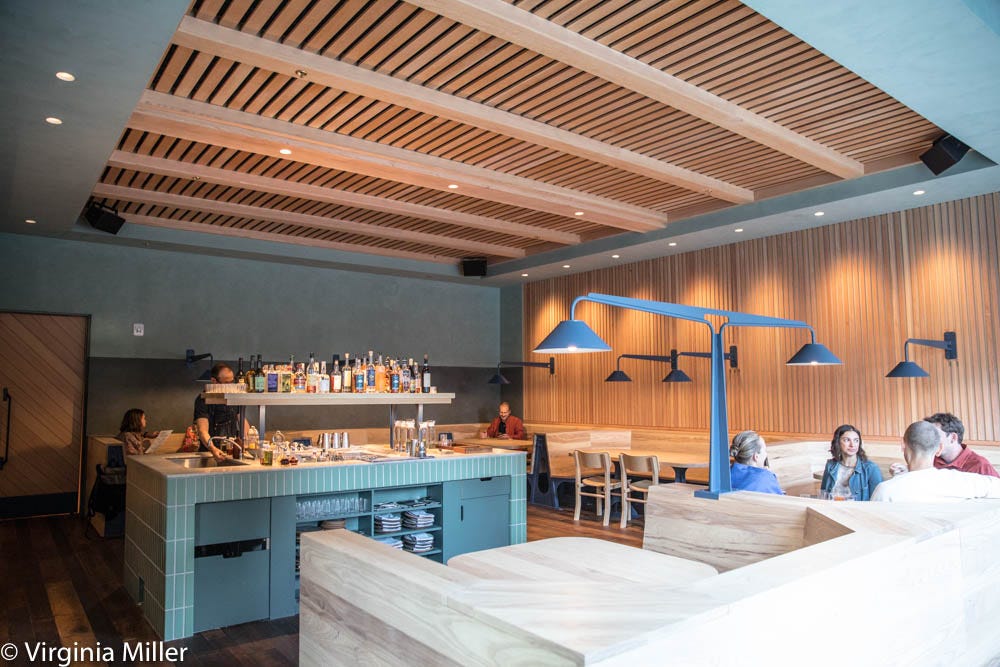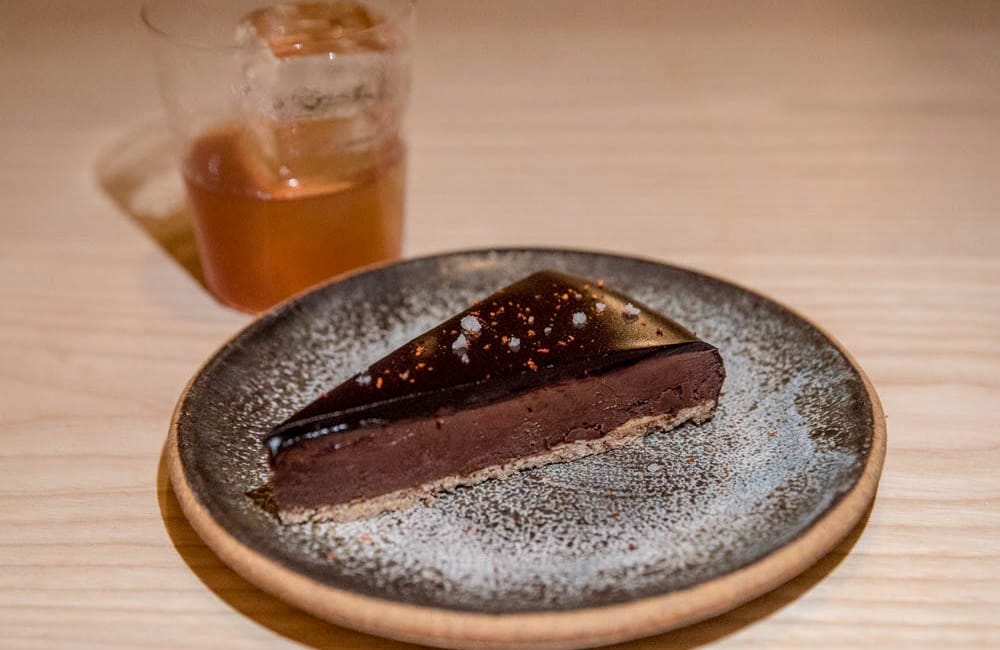Those of us who have been in dining, cocktails and spirits a long while know the importance of Bar Agricole since it opened in San Francisco’s SoMa district in 2011. Not only was it nominated every year since 2012 for James Beard Outstanding Bar Program in the nation — finally winning in 2019, but founder and bar vet Thad Vogler (who helped open pioneering bars like Bourbon and Branch) wrote an intriguing and definitive book on farmhouse-distilled and naturally sourced spirits, By the Smoke and the Smell: My Search for the Rare and Sublime on the Spirits Trail. His opinionated take on purity in spirits is thought provoking, calling out the few producers who adhere to such principles on all levels. Bar Agricole has also been home to chefs who have gone on to open major restaurants, like Brandon Jew of Michelin-starred Mister Jiu’s and Seth Stowaway of Osito.
I particularly loved Vogler’s Trou Normand, a pioneering spot I still haven’t seen the like of anywhere in the nation over eight years later with superb house charcuterie and cocktails alongside house selected barrels of Armagnac, Cognac and Calvados. Amid controversies of unpaid bills and wage theft, his shorter-lived Nommo and Obispo all closed alongside Trou Normand in September 2020, with Bar Agricole closing indefinitely in March 2020 around pandemic uncertainty despite originally planning a move to a new location.

After a long wait, on August 3, 2022, Bar Agricole reopened in an “off the beaten path” Mission Street location near Van Ness. The large, spacious, three-roomed space is only slightly reminiscent of the minimal, sleek, and lofty original. I’d call this Bar Agricole 2.0 or a new restaurant entirely, including some serious changes to right the controversies and missteps of the past. Their collaborative team approach includes elements like flattened hierarchy and group decision-making, to working towards getting the business B Corp certified with a very strict level of social and environmental requirements, while they plot out future offerings like profit sharing and stock options for a team that includes former Bar Agricole staff, some there since day one.
The biggest change is this location is home to a line of Bar Agricole single-origin spirits also expected to launch nationally. The front bar room — dubbed the “package room” — houses bottles they’ll be importing and selling in-house. You can come in to browse or take home a bottle of a spirit you loved at the bar or over dinner. This already makes it a truly unique bar, a space that will sell exclusive bottles directly from spirits producers who farm responsibly and use zero chemicals in their distilleries. To start, there’s an Agricole bottling of Rezpiral Destilados de Agave (Verde by Tio Chico or Tepeztate by Doña Berta), Kilchoman 100% Islay Single Cask Single Malt, 2007 Domaine Boingnères Armagnac or Leopold Bros. Single Cask Bourbon, with a few more coming before year’s end. I already love these spirits producers and this focus makes Bar Agricole a draw as a bar and shop… but the chef talent they brought on has me equally excited about the kitchen.

Former Bar Agricole chef Will Napoli and chef Nick Balla are helming the food menu. As I often wrote about Balla at restaurants pre-and post-the great Bar Tartine, his modern Eastern European-influenced dishes with touches of his time living in Japan, exuded a unique style and voice I have not tasted before or since. I was sad when he left SF to cook in Big Sur for a while — though I adore Big Sur (obviously; to see it is to adore it), I would rather have his cooking down the street at home. Thankfully, Balla is back, although what he and Napoli are cooking together is very different from Balla’s former restaurants. Just as with the spirits, the chefs heavily focused on purity in sourcing.
Aside from one charcoal-fuel oven, the kitchen is entirely electric-powered, the slatted wood ceilings hide soundproofing, while SF designer MaryMar Keenan of MMclay made the dishware. Trying to narrow down on the shared plates, I wanted to try their off-menu burger special but husband Dan, The Renaissance Man, and I went another direction on a recent weeknight.

Their house sourdough with cultured butter is already a standard, with the option to add tinned fish or house spreads like smoked eggplant and sesame, tomato jam or a rich duck liver pate given depth from Cognac. While these were good, I prefer their flatbread, crispy and light, graced with herbs, its accompanying turmeric yogurt and robust harissa the ultimate dip/spread of the night (pro tip: the flatbread is a fine accompaniment to any of the other dips, too).
Raw halibut diced up with tiny bits of preserved lemon and green strawberries and scooped into endive cups is a worthy “crudo” or light seafood starter, even if I wanted more or bigger slices of the green strawberry and lemon. A grilled squid salad over shelling beans in salsa macha feels simple and heartwarming, the warm mash of beans and squid enlivened by the salsa macha — again, which I could have used a bit more of — a “salsa” from Veracruz, Mexico, which is actually a rich chile oil doused with dried chiles, garlic, and nuts (typically peanuts or pumpkin seeds). I first fell in love with salsa macha in Mexico so glad to see it trend the last couple of years. At this point, it’s officially “hot,” as I’ve had it on dozens of menus locally and recently started to see it peek up in other U.S. cities.
The best two plates, however, began with a generous tomato salad marked by serpent cucumbers in nigella seeds. In some ways, it’s a straightforward showcase of the incomparable glory of California tomatoes at their peak, but a generous dusting of the seeds added contrast and the overall generosity of the dish wins you over.

An entree of silky black cod was the right combo of flaky, soft meat and crispy skin, contrasted by robust, flavor-packed Jimmy Nardello peppers and almonds, brightening the dish, recalling Spain by way of California. For dessert, I didn’t think I could finish a dark, rich rye chocolate tart in sea salt and espelette pepper. I could. It is earthy goodness, warmed by the rye grain/bread notes, ideal with a spirits pour to end the night.
The cocktails also embraces lean simplicity with high quality, made with care. A limited number of ingredients are housed in an island in the center dining room (with a tasting room-like bar in the “package room.”) From this island filled with hand-cut ice, bottles, and ingredients, staff share all responsibilities, weaving from waiting on tables to making cocktails to bringing dishes. We were waited on by a few different people who knew and seemed to care about the food and drink on all levels.
Bar Agricole longtimers will recognize a few favorites from the early days, like their Martinique-worthy Ti’ Punch cocktail, as well as the Rye Gin Old Fashioned. Purity and the highest quality ingredients reign, whether 2007 Vintage Armagnac and Vermouth di Polcenigo in the Improved Cocktail, or two mini-Old Fashioneds featuring two bourbons from Leopold Bros., made exactly the same way but showcasing how different the flavors can be between bourbon barrels.

An Agave Daisy, made with the aforementioned mezcal-esque Rezpiral Destilados de Agave and plum syrup, drinks tart, juicy, and mineral, a refresher layered with earth and agave vegetal notes. The Fruit Cup with Vigneron Armagnac, house Pimm's, lemon, a strawberry syrup — showing off the glories of the season, changing with the seasons — and fresh ginger is bright and bold, maybe the most crowd pleasing of the cocktails I tasted.
The “100% Islay Single Cask Scotch, Cherry Brandy, Curaçao & Aromatic Bitters” cocktail is the priciest at $32 — with higher prices on a number of cocktails given the spirits and ingredient quality/cost. It’s a stunner that takes inspiration from but improves upon a classic Blood and Sand, often cloying with scotch, orange juice, Cherry Heering, and sweet vermouth. Bar Agricole’s twist features the house Kilchoman whisky with orange curacao, lemon juice, house cherry liqueur, and sour cherry and aromatic bitters. Its smoky, tart richness holds silky depth yet a buoyant fruitiness (and it pairs beautifully with the rye chocolate tart, by the way).
There are a few choice wines — and just one excellent beer, Brasserie Lebbe “L’Almathée” Farmhouse Ale (a brewery with a superb story and worth ordering) — each embodying the same ethos of sustainable, untainted farming and production. A Jean-Marc Gilet Les Perruches Vouvray, for example, is a Loire Valley Chenin Blanc from a very small production, fifth generation winemaker, exuding notes of pear, citrus and a rich minerality, ideal with the food.

There are many who will quibble with the price points, whether a $26 tomato salad or $32 cocktail. These factors can make a night here pricey beyond what the casual, open space suggests. But there are more affordable bites and drinks, while dishes like the tomato salad are a larger portion than at most mid-range, artisanal restaurants. Again, it’s the meticulous sourcing of sustainable, methodical producers in food and drink that do cost more, as well as cocktails made with spirits with age and complexity, the likes of which are rarely used in cocktails given their higher cost.
The new Bar Agricole is a spirits hub and ambitious project from a drink vet — with a chef (Nick Balla) I’d love to see showcase his brilliant, unique perspective on a plate even more alongside chef Napoli. But it also feels like a sleek yet casual, elevated yet humble tribute to farming, in the glass and on the plate. It’s a welcome newcomer that doesn’t feel like a continuance of the original but rather a place reinvented, looking to right past mistakes and peer ahead to a new kind of restaurant/bar/spirits shop with an equitable business model. I, for one, look forward to seeing and tasting how it evolves.
// 1540 Mission Street; https://baragricole.com







